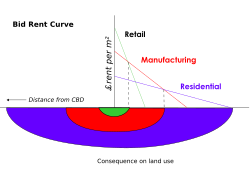
The concentric zone model, also known as the Burgess model or the CCD model, is one of the earliest theoretical models to explain urban social structures. It was created by sociologist Ernest Burgess in 1925. [1] [2]

The concentric zone model, also known as the Burgess model or the CCD model, is one of the earliest theoretical models to explain urban social structures. It was created by sociologist Ernest Burgess in 1925. [1] [2]
Based on human ecology theory done by Burgess and applied on Chicago, it was the first to give the explanation of distribution of social groups within urban areas. This concentric ring model depicts urban land usage in concentric rings: the Central Business District (or CBD) was in the middle of the model, and the city is expanded in rings with different land uses. It is effectively an urban version of Von Thünen's regional land use model developed a century earlier. [3] It influenced the later development of Homer Hoyt's sector model (1939) and Harris and Ullman's multiple nuclei model (1945).
The zones identified are:
The model is more detailed than the traditional down-mid-uptown divide by which downtown is the CBD, uptown the affluent residential outer ring, and midtown in between.

Burgess's work helped generate the bid rent curve. This theory states that the concentric circles are based on the amount that people will pay for the land. This value is based on the profits that are obtainable from maintaining a business on that land. The center of the town will have the highest number of customers so it is profitable for retail activities. Manufacturing will pay slightly less for the land as they are only interested in the accessibility for workers, 'goods in' and 'goods out'. Residential land use will take the surrounding land.
The model has been challenged by many contemporary urban geographers. First, the model does not work well with cities outside the United States, in particular with those developed under different historical contexts. Even in the United States, because of changes such as advancement in transportation and information technology and transformation in global economy, cities are no longer organized with clear "zones" (see: Los Angeles School of Urban Analysis).
{{cite book}}: ISBN / Date incompatibility (help)